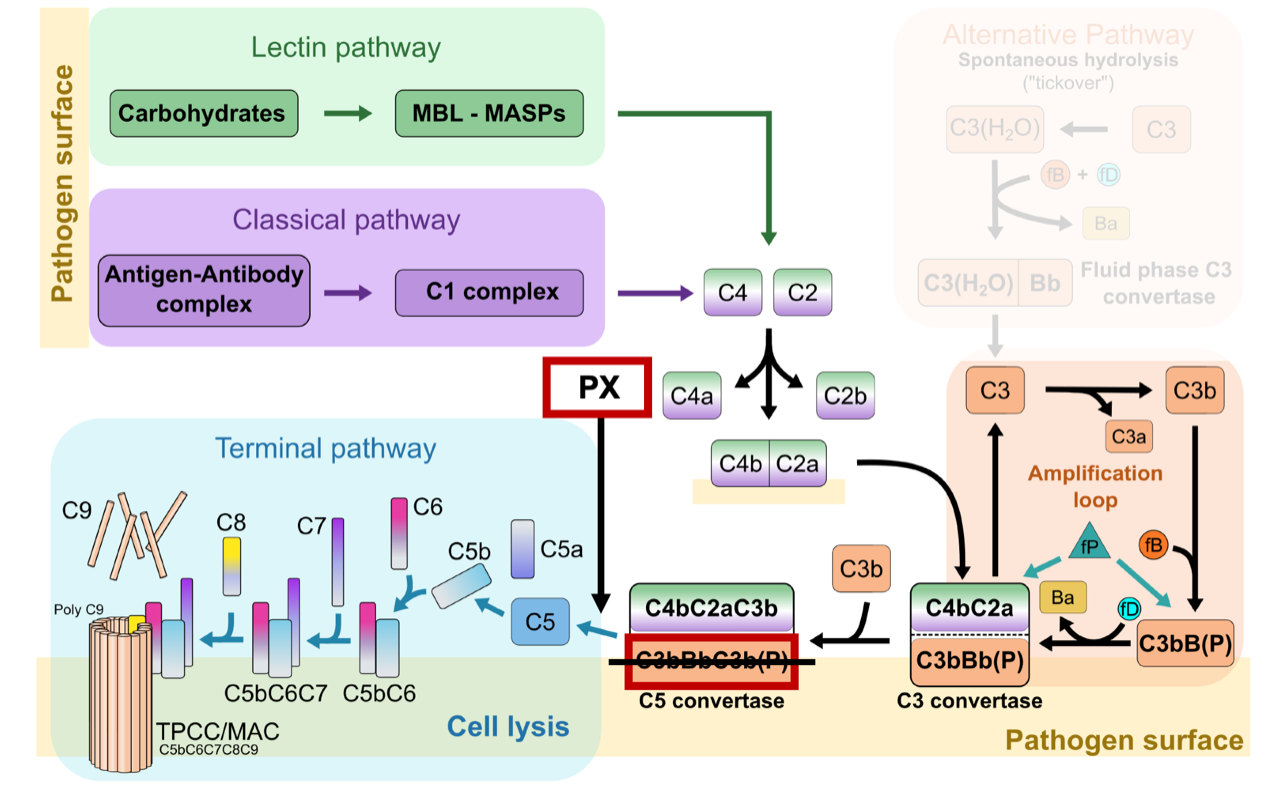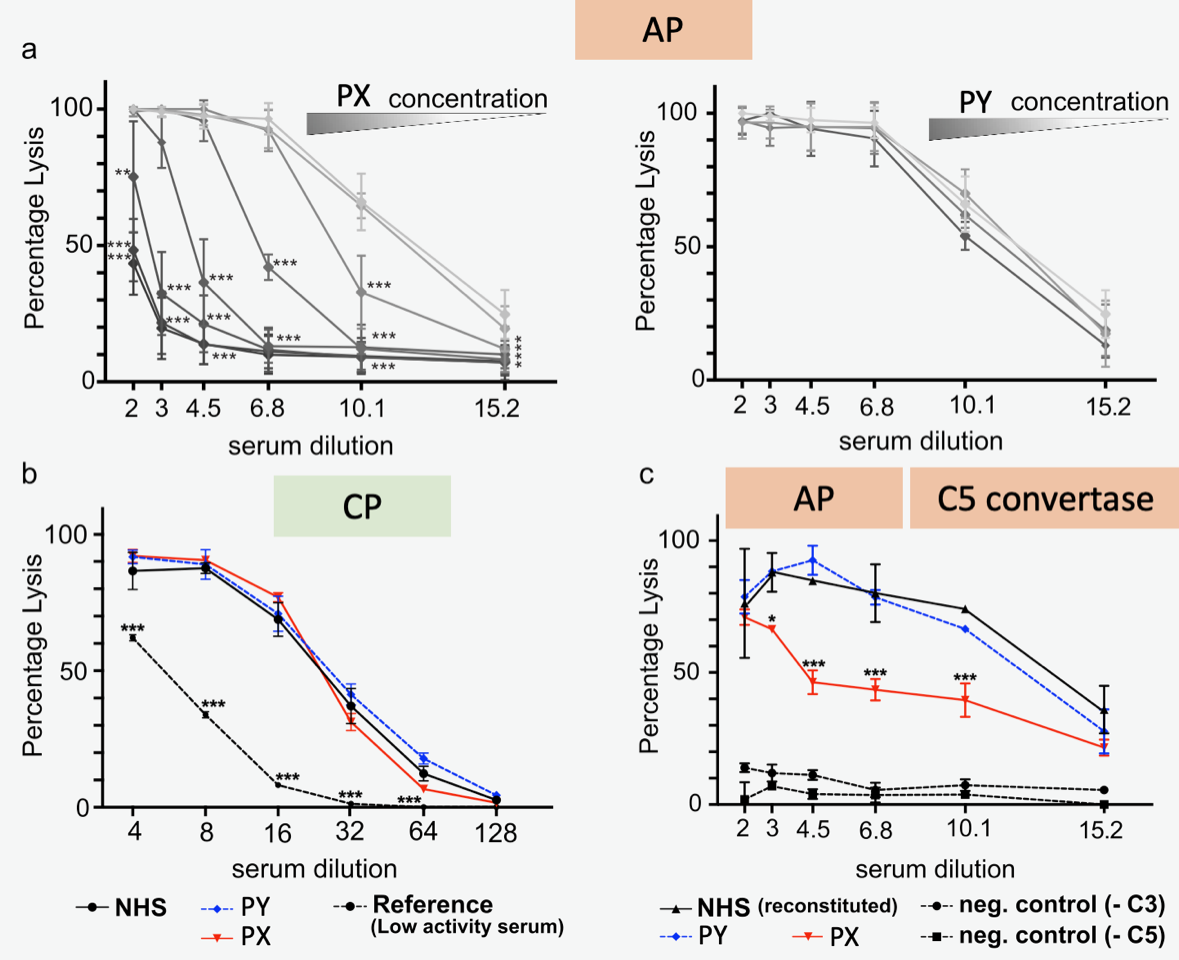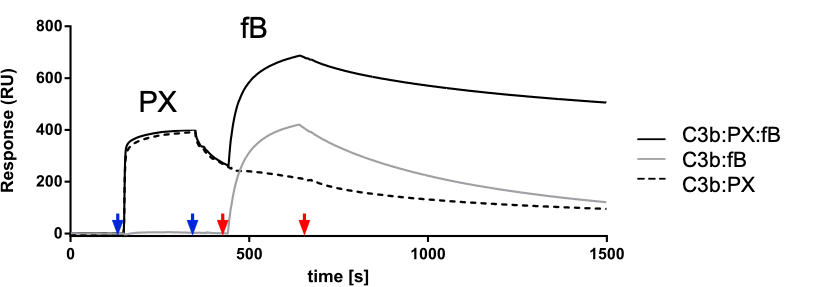Scientists:
Sebastian Zoll, Hagen Sülzen
Challenge
Excessive activation of the innate immune response has been implicated as a significant contributing factor in the pathogenesis of numerous diseases. These include e.g. autoimmune diseases, Alzheimer's syndrome, schizophrenia, atypical hemolytic-uremic syndrome, angioedema, macular degeneration, and Crohn's disease. The three conditions, atypical hemolytic uremic syndrome (aHUS), C3 glomerulopathy (C3G), and paroxysmal nocturnal hemoglobinuria (PNH), exemplify the consequences of complement dysregulation disorders, which arise due to underlying genetic abnormalities. In each case, the complement system, a vital component of the immune system responsible for host defence and regulation, is affected by genetic mutations. Complement hyperactivation disrupts cellular self-recognition, leading to uncontrolled lysis of red blood and endothelial cells, which can ultimately result in kidney failure.
The different complement pathways and the mode of PX action:

The classical (CP) and the lectin pathway (LP) are triggered by specific antigens on pathogen surfaces. The alternative pathway (AP) can start spontaneously by a nucleophilic attack of water on metastable native C3, resulting in generation of the fluid phase C3 convertase, but it also serves as an amplification pathway after CP and LP. CP and LP share the same C3 and C5 convertases CP/LP C4bC2a and CP/LP C4bC2aC3b, respectively. Analogue to C3b of the AP C3 convertase, CP/LP C3 convertase formation is initiated by covalent binding of thioester-containing C4b to the pathogen membrane. Both CP/LP convertases are structurally distinct from the AP C3 and C5 convertases AP C3bBb(P) and AP C3bBbC3b(P), but have the same substrate specificities. Properdin stabilises the AP convertases. Cleavage of C5 initiates the terminal pathway. C5b sequentially binds C6, C7, C8 and poly-C9 and inserts into the plasma membrane where it forms a lytic pore, the membrane attack complex. PX binding to C3b inhibits the AP C5 convertase. This restricts the AP and blocks progression to the TP. PX leaves the CP, LP and the amplification loop unaffected. MBL, Mannan-binding lectin; MASP, MBL-associated serine proteases; fB, factor B; fD, factor D; Ba, factor B fragment a; Bb, factor B fragment b; fP, factor P (properdin); MAC, membrane attack complex; TPCC terminal pathway complete complex.
Technology
We have identified a protein-based inhibitor, PX, that interacts with all functionally relevant C3 variants with high affinity. Through its interaction with C3b, PX specifically inhibits the C5 convertase (AP C5 convertase, C3bBbC3b) of the alternative pathway, the complement pathway affected by hyperactivation. Unlike current, commercially available inhibitors, PX does not interfere with the activity of the other complement pathways, the lectin pathway and the classical pathway which share the same C5 convertase (CP/LP C5 convertase, C4bC2aC3b). PX does also not inhibit the C3 convertase of the alternative pathway (AP C3 convertase C3bBb) leaving the amplification loop unaffected.
In vitro, PX causes a 90% inhibition of the AP, while no inhibitory effect on the CP can be observed. When acting on pre-assembled AP C5 convertase, C3bBbC3b, PX still causes 40% inhibition of cell lysis. PX therefore interferes with both the assembly as well as the activity of the AP C5 convertase.
PX interacts with all functionally relevant C3 variants:

Surface plasmon resonance sensorgrams showing the kinetics of PX binding to various C3 species. Structures of C3 fragments are shown above the corresponding sensorgrams. The atomic structure of C3(H2O) is unknown, but its overall architecture has been suggested to be similar to C3b which is shown here instead, indicated with a question mark.
PX is a selective inhibitor of the alternative pathway (AP) C5 convertase:

Haemolysis assays (AP50 test) measuring the lysis of rabbit erythrocytes in human serum in presence of PX (left) and PY (right, negative control) following activation of the alternative complement pathway (n =3; ± std S. D; ** indicates p ≤ 0.01; *** indicates p ≤ 0.001). PX, but not PY reduced haemolysis in a significant, concentration-dependent manner. Colour gradients indicate protein dilutions ranging from of 7.5 - 0 µM. b Haemolysis assay (CH50 test) measuring the lysis of sensitised sheep erythrocytes in human serum in presence of PX (red solid line), PY (dashed blue line) and without added inhibitors (NHS, normal human serum; solid black line) following activation of the classical complement pathway (n=4; ± std S. D). At 24 µM, neither PX nor PY showed significant inhibition of erythrocyte lysis. Low complement activity reference (n=3, *** indicates p ≤ 0.001) is depicted with a dashed black line c Adapted AP50 haemolysis assay using C5- and C3-depleted human sera. Binding of PX to assembled AP C5 convertase C3bBbC3b significantly reduced haemolysis (red solid line). No reduction in haemolysis could be detected for PY (dashed blue line). Human sera depleted for either C5 (-C5) or C3 (-C3) did not cause haemolysis (dashed black lines). Incubation of erythrocytes with C5-depleted serum followed by incubation with C3-depleted serum, reconstituted haemolytic activity (NHS (reconstituted), solid back line). (n =3; ± std S. D; *indicates p ≤ 0.05** ; indicates p ≤ 0.01; *** indicates p ≤ 0.001). line.
PX does not interfere with assembly of the AP C3 convertase:

SPR sensorgrams showing the AP pro-convertase formation in presence of PX. C3b was immobilised onto the chip and PX and factor B subsequently injected (solid black). Control injections were performed PX (black dashes) or factor B (solid grey) only. Beginning and end of the injections are marked with arrows (PX: blue, factor B: red).
Commercial opportunity
The treatment of complement dysregulation diseases, notably aHUS and PNH, currently involves the use of eculizumab/soliris, a monoclonal antibody that targets complement factor C5 in the terminal pathway of the complement cascade. It is important to note that all three complement pathways converge in the terminal pathway, and inhibiting an enzyme at this stage affects other branches of the complement system as well. Consequently, patients receiving eculizumab or coversin, another protein-based C5 inhibitor, are immunocompromised and may have an increased susceptibility to bacterial infections, particularly Neisseria, which can lead to meningitis. This highlights the need as well the potential to develop an inhibitor that selectively targets components of the alternative complement pathway, which is implicated in the aforementioned diseases. Such an inhibitor would preserve the integrity of the other complement pathways, enabling patients to maintain a fundamental innate immune response.
In summary, the existing drugs do not adequately target specific complement-mediated conditions, leaving a gap in effective treatment options. 1-2 persons per million live with alternative pathway dysregulation diseases. The complement therapeutics market forecast by 2032 is $33B.
Development status
Preclinical. The effectiveness of PX has been demonstrated in cell-based and biophysical studies. Toxicological, pharmacokinetic and immunological studies in mice are underway to further evaluate its safety.
Categories
Autoimmune diseases; Complement system dysregulation; C3 glomerulopathy
Keywords
complement system alternative pathway inhibitor PX C3 glomerulopathy